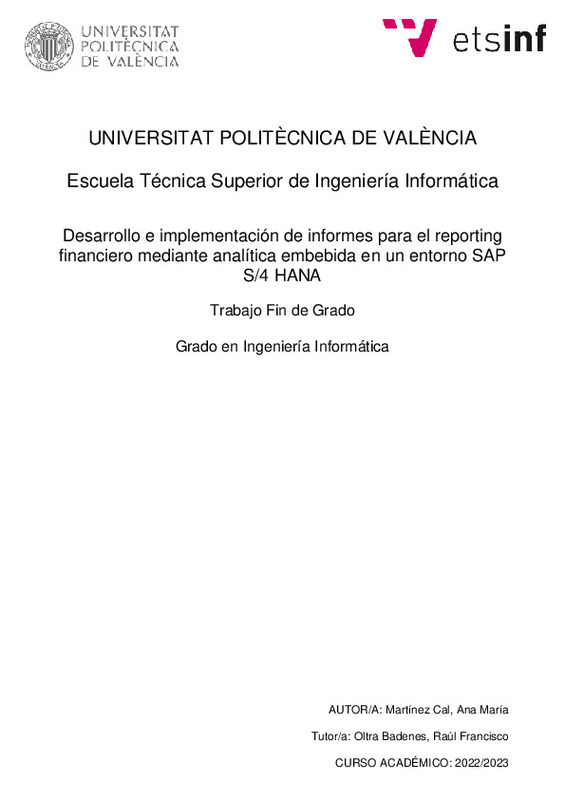|
Resumen:
|
[ES] El objetivo de este proyecto es realizar dos informes usando analítica embebida, que permite
obtener la información directamente del entorno transaccional (ERP), y por tanto, en tiempo
real. De este modo, no es ...[+]
[ES] El objetivo de este proyecto es realizar dos informes usando analítica embebida, que permite
obtener la información directamente del entorno transaccional (ERP), y por tanto, en tiempo
real. De este modo, no es necesario transferir los datos a un sistema analítico, lo cual, no
permitiría disponer de la información actualizada al 100%. El primer informe “PYG Resumen”
es una cuenta de resultados analítica, que contendrá datos financieros reales y planificados.
Este informe permitirá conocer el resultado agrupado por Sociedad, tanto en datos reales
como planificados, del ejercicio actual y del ejercicio anterior, así como las diferencias entre
ambos. El segundo Informe “Rentabilidad Cliente/Artículo” de rentabilidad por cliente y por
artículo permitiré analizar la rentabilidad cliente/artículo a través de una serie de ratios.
El proyecto constará de tres fases. La primera fase se centrará en el análisis de la parte
funcional financiera, donde se recogen las especificaciones demandadas por el
cliente/usuario, y que permitirán la implementación técnica. En la segunda fase se utilizará la
analítica embebida, concretamente “Hana Views”, para conseguir el objetivo del presente
proyecto. Estas vistas permitirán modelar la información del origen de datos, y hacer los
cálculos necesarios hasta obtener cada uno de los indicadores. Se utilizará la herramienta
“Hana Studio”, sobre una Base de Datos HANA, para realizar el desarrollo. Las Hana Views
son flujos de información donde se pueden aplicar filtros, agregaciones, fusionar datos, etc.
El origen de los datos, fundamentalmente son las tablas ACDOCA y ACDOCP, las cuales se
fusionarán con otras tablas para complementar la información. Posteriormente, se añadirán
ratios calculados y restringidos, para así devolver el resultado adecuado. La tercera y última
fase será la implementación del reporting en la capa superior, donde deben crearse las
queries necesarias para que el usuario pueda explotar la información.
[-]
[CA] L'objectiu d'aquest projecte és realitzar dos informes usant analítica embeguda, que permet
obtindre la informació directament de l'entorn transaccional (ERP), i per tant, en temps real.
D'aquesta manera, no és ...[+]
[CA] L'objectiu d'aquest projecte és realitzar dos informes usant analítica embeguda, que permet
obtindre la informació directament de l'entorn transaccional (ERP), i per tant, en temps real.
D'aquesta manera, no és necessari transferir les dades a un sistema analític, la qual cosa, no
permetria disposar de la informació actualitzada al 100%. El primer informe “PYG Resum” és
un compte de resultats analítica, que contindrà dades financeres reals i planificats. Aquest
informe permetrà conéixer el resultat agrupat per Societat, tant en dades reals com planificats,
de l'exercici actual i de l'exercici anterior, així com les diferències entre tots dos. El segon
Informe “Rendibilitat Client/Article” de rendibilitat per client i per article permetré analitzar la
rendibilitat client/article a través d'una sèrie de ràtios.
El projecte constarà de tres fases. La primera fase se centrarà en l'anàlisi de la part funcional
financera, on es recullen les especificacions demandades pel client/usuari, i que permetran la
implementació tècnica. En la segona fase s'utilitzarà l'analítica embeguda, concretament
“Hana Views”, per a aconseguir l'objectiu del present projecte. Aquestes vistes permetran
modelar la informació de l'origen de dades, i fer els càlculs necessaris fins a obtindre
cadascun dels indicadors. S'utilitzarà l'eina “Hana Studio”, sobre una Base de dades HANA,
per a realitzar el desenvolupament. Les Hana Views són fluxos d'informació on es poden
aplicar filtres, agregacions, fusionar dades, etc. L'origen de les dades, fonamentalment són
les taules ACDOCA i ACDOCP, les quals es fusionaran amb altres taules per a complementar
la informació. Posteriorment, s'afegiran ràtios calculats i restringits, per a així retornar el
resultat adequat. La tercera i última fase serà la implementació del reporting en la capa
superior, on han de crear-se les queries necessàries perquè l'usuari puga explotar la
informació.
[-]
[EN] The objective of this project is to produce two reports using embedded analytics, which allows
obtaining the information directly from the transactional environment (ERP), and therefore, in
real time. In this way, ...[+]
[EN] The objective of this project is to produce two reports using embedded analytics, which allows
obtaining the information directly from the transactional environment (ERP), and therefore, in
real time. In this way, it is not necessary to transfer the data to an analytical system, which
would not allow us to have 100% updated information. The first report "PYG Summary" is an
analytical income statement, which will contain actual and planned financial data. This report
will show the results grouped by company, both in actual and planned data, for the current
and previous year, as well as the differences between the two. The second report
"Customer/Article Profitability" of profitability by customer and by article will allow to analyze
customer/article profitability through a series of ratios.
The project will consist of three phases. The first phase will focus on the analysis of the
financial functional part, where the specifications demanded by the customer/user are
collected, and which will allow the technical implementation. In the second phase, embedded
analytics, specifically "Hana Views", will be used to achieve the objective of this project. These
views will allow modeling the information from the data source, and make the necessary
calculations to obtain each of the indicators. The "Hana Studio" tool will be used, on a HANA
Database, to carry out the development. Hana Views are information flows where filters,
aggregations, data merging, etc. can be applied. The origin of the data, fundamentally are the
ACDOCA and ACDOCP tables, which will be merged with other tables to complement the
information. Subsequently, calculated and restricted ratios will be added, in order to return the
appropriate result. The third and last phase will be the implementation of the reporting in the
upper layer, where the necessary queries must be created so that the user can exploit the
information.
[-]
|







